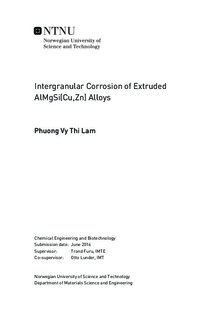Intergranular Corrosion of Extruded AlMgSi(Cu,Zn) Alloys
Master thesis
Permanent lenke
http://hdl.handle.net/11250/2411084Utgivelsesdato
2016Metadata
Vis full innførselSamlinger
Sammendrag
In general, the 6xxx series alloys (AlMgSi) are considered to be resistant to intergranular corrosion (IGC) in marine environments. However, the addition of copper to increase peak hardness has proven to increase the IGC susceptibility. The detrimental effect on IGC resistance is believed to be caused by the formation of a nanoscale continuous Cu rich film confined along the grain boundaries of the material. Evaluation of IGC susceptibility in heat treatable aluminium alloys is generally carried out by metallographic examination of specimens after exposure in an acidified chloride test solution. Experience has revealed that accelerated corrosion testing is highly dependent on several factors. Especially extruded specimens with a region comprised of highly directional grains in the centre and a recrystallised surface have shown to experience severe corrosion inwards the fibrous area. This observation is believed to influence the extent of corrosion on the recrystallised specimen surface. Extruded copper containing AA6082 alloys modified with various Zn levels were corrosion tested according to BS-ISO 11846 (method B) in the T5 and T6 temper. Several IGC test parallels were conducted to examine how the edge microstructure affects the IGC resistance of these alloys. The influence of Zn on IGC susceptibility was investigated as well. Optical microscopy (LM) was used to characterise the microstructure of the T5 and T6 profiles, and scanning transmission electron microscopy (STEM) and energy dispersive spectroscopy (EDS) analysis were conducted to identify and characterise the grain boundary chemistry in the fibrous microstructure. Assessment of corrosion susceptibility was done by metallographic examination in LM and scanning electron microscopy (SEM) after accelerated corrosion testing. Results reveal that the edge microstructure had a significant effect on the corrosion behaviour of the recrystallised surface. Corrosion susceptible T5 tempered alloys with a fibrous microstructure and recrystallised surface experienced extensive edge corrosion, whereas the surface was nearly resistant to IGC. This was especially evident for the Cu containing alloys without Zn and with 0.21 wt% Zn. By covering the edges, extensive IGC was observed at the surface on the alloys that previously appeared to be resistant to IGC. The completely recrystallised T6 profiles experienced limited edge corrosion, while severe IGC occurred on the surface in susceptible alloys. The corrosion behaviour did not change when the edges were covered. The difference in IGC extent dependent on edge micsrostructure in the susceptible T5 alloys points towards that the BS-ISO 11846 standard is inadequate to account for edge effects. Furthermore, results indicated that IGC susceptibility increased with increasing Zn content and EDS analysis of the T5 profile with 0.60 wt% Zn revealed a Cu rich film along the grain boundaries, whereas the Zn primarily remained in solid solution. Zn in solid solution might have activated the particle free zone (PFZ) further thus accelerating the IGC mechanism.
